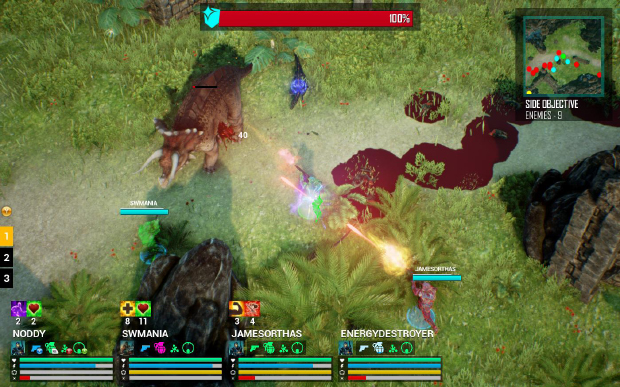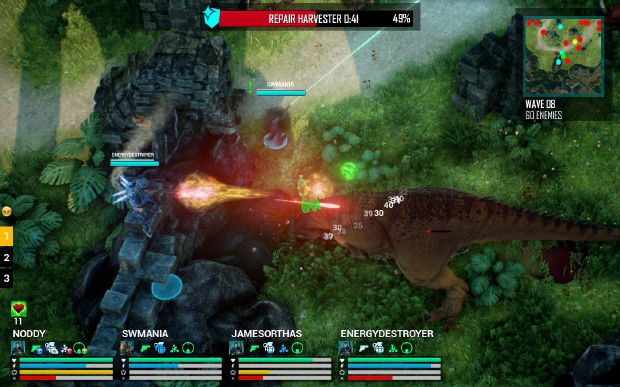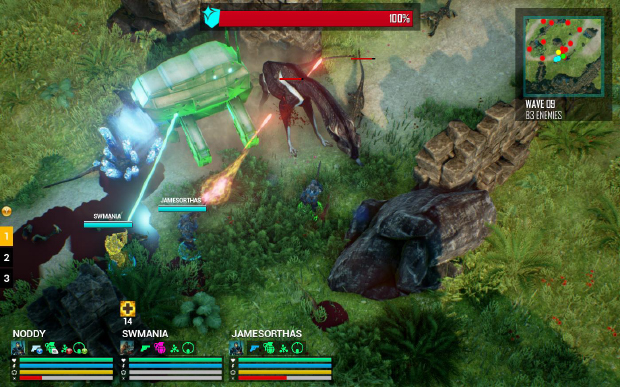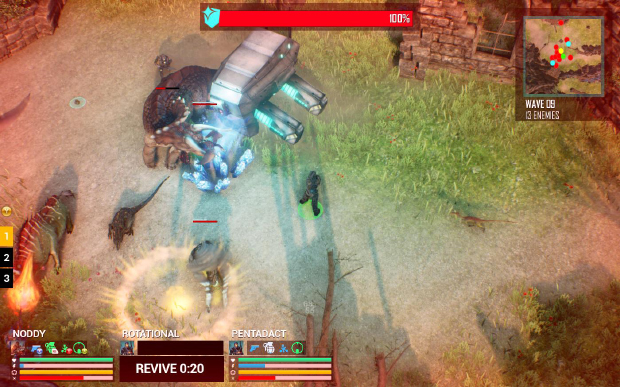Premature Evaluation: Guardians of Orion
Tyrannosaurus Rekt
Each week Marsh Davies leaps from his dropship into the untamed primordial land of Early Access and unfeelingly obliterates the nascent species he finds. This week he’s turning dinosaurs to chum in Guardians of Orion, a co-op wave-survival shooter. It’s also a top-down game - which you wouldn’t necessarily guess from some of the footage used to advertise the game on its Steam Store page.
I don’t know who this Orion is but most of your time in the game is spent guarding a slow-moving hovercraft as it pootles about hoovering up crystals and inexplicably barking about pizza. Of course, as we all know, the one thing that offends dinosaurs more than the theft of crystals is unexplained developer in-jokes, and so they have, as an entire clade, put aside their differences to unleash vicious retribution upon this harvesting machine. Though you may have some sympathy with the dinosaurs here, you and up to three teammates are deployed to ensure the crops will not fail, bringing to bear your vast technological superiority, which, divided among three playable classes, includes shotguns, assault rifles, grenades, short range teleportation, invisibility, jetpacks and healing beams.
Nonetheless, the dinosaurs' numbers alone provide a challenge, and some of their famously large members - Tyrannosaurus Rex, Bertie Three Horns, Twatadillo and MegaHorse - can do you considerable harm while absorbing huge amounts of lead. This is to say nothing of their robot allies, who spit out grenades or chop you up with glowing katanas. It makes combat a frantic affair, as you use your short-range teleportation to blink out of the mosh pit while thinning the herd of fast moving enemies or concentrating fire on the major threat, all the while keeping an eye on your harvester’s health.
This is a crowded genre with many fine exemplars, however, and Guardians of Orion currently struggles to throw up the sort of split-second tactical switches which keep combat tense and interesting across successive waves. Fighting one dinosaur is much like fighting another: regardless of its size or health pool, you don’t want to get stuck in its teeth, so you dodge and blink away, chipping down its health from range. It’s a little one-note. These sorts of games benefit from abrupt changes in the flow of combat - either forced upon you by the combination of enemies you face, or resulting from a synergy of your team’s abilities. There are signs that this is what Guardians is working toward: your support class creates a healing bubble, which naturally draws players and their dino pursuers to a single point. The need to keep your harvester in good health also forces the team to refocus, and robot soldiers with range weapons defy the usual kite-n-kill tactic.
But there isn’t yet the critical mass of divergent tactics or unique threats for memorable combat anecdotes to emerge from the carnage. Indeed, some of the classes’ unique skills seem a missed opportunity in this regard. The assault trooper is easily the most versatile, with a rifle, explosive grenades and a jetpack which allows him to briefly float above enemies or reposition himself on outcrops, causing the enemy’s pathfinding AI to wig out. The shotgun-wielding support class can deploy a healing bubble or lob smoke grenades, the use of which I have yet to detect. The recon class, meanwhile, can turn invisible for a short period of time - a peculiar skill in a game entirely not about stealth. The main tactical purpose seems to be temporarily offloading enemy aggro onto your teammates, for which they are unlikely to thank you, though later upgrades can give you a significant damage boost too. She also has an EMP grenade for taking out the otherwise highly-resilient robot enemies, but since they aren’t guaranteed to turn up in any given wave, it makes her a little over-specialised.
All three classes get a short-range healing beam-gun, that they can use to patch up colleagues, or themselves, or to repair the harvester. There’s also persistent character progression - each class gains XP as you play them, allowing you to unlock portions of a skill tree - Jurassic perks, if you will. Mostly these are simple buffs, or cooldown reductions, but the highest levels offer some mechanical changes: the support’s healing bubble can be upgraded to deal damage to enemies, while the assault’s jetpack now sets creatures on fire. Though even with low level characters, the way the game graduates failure makes its challenge very manageable. You can get downed and revived rather than killed outright, but should your colleagues dawdle, or you end up being swallowed whole by a T-rex, then you’ll respawn on the dropship and traipse back to the fight within half a minute or so. The game’s only over if the dinos destroy the harvester, and even that is a two tier process: you can top up its health at any point, but once it’s downed, you have a second chance to get it all the way back to full health within a time-limit.
It makes the game relatively lenient, even on the Insane difficulty level, as it’s rare that an entire team will be wiped in such a way that no one’s available to resurrect the harvester. I don’t mind that this shifts the achievement from simple wave completion to a score based on the number of times you died and revived, but in other ways I’m not sure the game quite knows how to modulate its challenge: the principal difference between difficulties is the number of enemies, but there’s a sweet spot in the variety and combinations of enemies that both too low or too high a difficulty misses.
There are other curiosities, too, like the prodigious quantity of purposeless shlepping. Die and your trip back from the dropship is a punitively uneventful slog across a large and visually homogenous landscape. Side missions present a similar annoyance. Popping up between waves, these are identical in every other way to a regular wave but for the fact that the dinosaurs are clustered over the other side of the map and seem to have abandoned any interest in your harvester, forcing you to jog over, sometimes for minutes, kill them and then jog all the way back.
The three available environments and one game mode do not seem overly generous given the price of this Early Access release - and this will only rise as the game’s content swells as it heads towards its December 2016 release date. That said, I’m not sure more stuff is as important a distinguishing feature within this busy genre so much as a considered and honed interaction between the existing elements, creating distinct emergent spectacle and interesting avenues for cooperation. Without that, Guardians of Orion risks feeling prehistoric in the one way it doesn’t intend.
Guardians of Orion is available from Steam for £13.50. I played version 1.0.1 on 04/12/2015.





